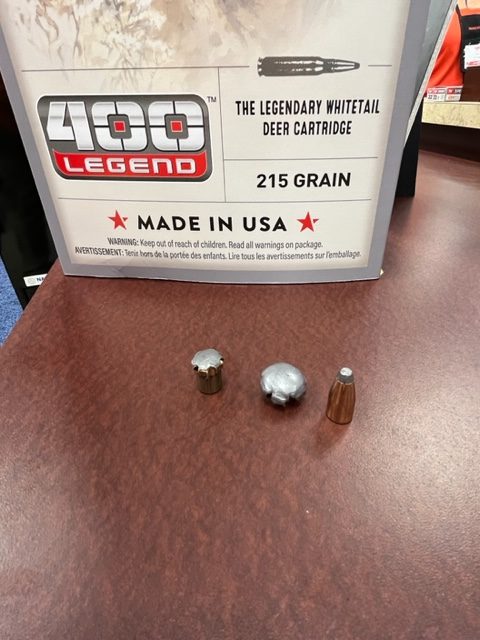Winchester Ammunition, a division of Olin Corporation, announced a new cartridge called 400 Legend at the recent NRA Annual Meeting. It is a straight walled cartridge aimed at hunters in those states, primarily in the Mid-West, that prohibit the use of necked cartridges for deer hunting.

The cartridge is reported to have double the energy of a 12 gauge slug at 100 yards, 55% less recoil than a 12 gauge slug, and 20% more energy than the venerable .30-30 Winchester. It is an upgrade over the 350 Legend. The representative that I spoke with at the NRA Annual Meeting denied that they were trying to one-up the Federal/Remington 360 Buckhammer and that they had been working on it long before the SHOT Show.
In today’s email, I received a press release from Savage Arms announcing their plans to chamber a number of their rifles in 400 Legend.
Savage Arms is proud to partner with Winchester® Ammunition to bring deer hunters several rifles chambered in 400 Legend in time for 2023 hunting seasons. The new hard-hitting, yet mildly recoiling, caliber means new opportunities for deer hunters across the country. Savage will launch the 400 Legend in the 110 Apex Hunter XP, 110 Hog Hunter and Axis II XP—but will also chamber it in another 11 models in 2023.
Straight-walled cartridges, and especially the 400 Legend’s predecessor the 350 Legend, were born for states like Ohio and Michigan. The premise being bring modern projectiles and cartridge technologies to areas, states and hunters originally limited to shotgun slug or historically limited rifle caliber options. Due to the popularity of these cartridges that has been driven by performance—straight-wall options have gained traction outside of traditional shotgun slug areas as well. The 400 Legend will no doubt continue this legacy and Savage has responded by adding it to so many rifles in its lineup.
You are probably saying to yourself, “That’s nice but so what!”.
Federal and Remington, makers of the 360 Buckhammer ammo, are part of the Sporting Products Division of Vista Outdoor. Savage Arms was a division of Vista Outdoor from 2013 until 2018 when it was spun off in a leveraged-buyout to return to its roots as an independent company. If they still had been part of Vista Outdoor, I would think that they would have gone with the Federal/Remington 360 Buckhammer from sister companies over the 400 Legend.
I am neither pro-Legend nor anti-Buckhammer. I just found it interesting that a former division of Vista Outdoor went with a competitor’s new cartridge instead of one from their old sister companies.
